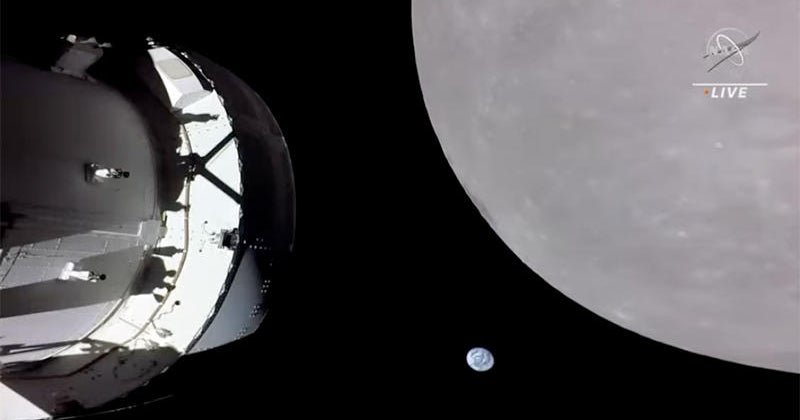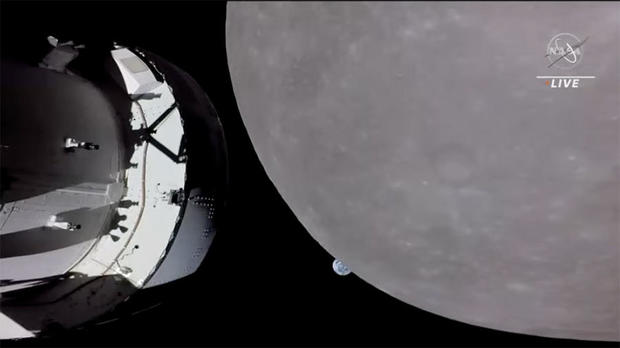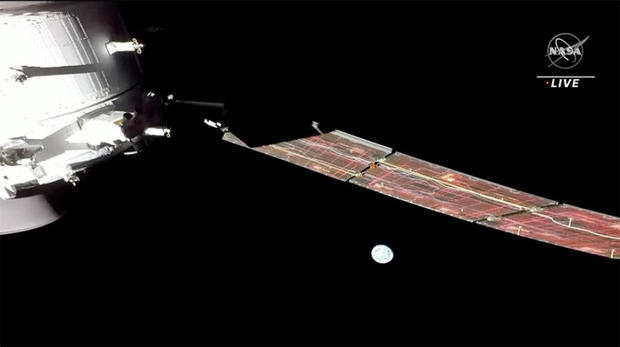
Out of contact on the far side of the moon, NASA’s unpiloted Orion crew capsule carried out a critical rocket firing and lunar flyby Monday, flinging the craft toward a distant orbit for tests intended to pave the way to a piloted flight in 2024.
NASA managers met Saturday, four days after Orion’s sky-lighting launch, and gave flight controllers a “go” to proceed with Orion’s “outbound powered flyby” maneuver, a two-and-a-half-minute firing of the spacecraft’s main engine starting at 7:44 a.m. EST Monday.

Dramatic live video from cameras mounted on the spacecraft showed Earth slowly approaching the limb of the moon and then disappearing as Orion passed out of contact behind the moon at 7:25 a.m. Nineteen minutes later, still out of contact, Orion executed the engine firing on its own as planned.
 Two images from a camera mounted on one of the Orion spacecraft’s solar arrays show the capsule’s view a few minutes before passing out of view on the far side of the moon, cutting off contact with flight controllers. NASA TV
Two images from a camera mounted on one of the Orion spacecraft’s solar arrays show the capsule’s view a few minutes before passing out of view on the far side of the moon, cutting off contact with flight controllers. NASA TV  Two images from a camera mounted on one of the Orion spacecraft’s solar arrays show the capsule’s view a few minutes before passing out of view on the far side of the moon, cutting off contact with flight controllers. NASA TV
Two images from a camera mounted on one of the Orion spacecraft’s solar arrays show the capsule’s view a few minutes before passing out of view on the far side of the moon, cutting off contact with flight controllers. NASA TV
A few minutes after that, the spacecraft made its closest approach to the moon at an altitude of about 81 miles, moving back into contact with flight controllers at 7:59 a.m. A striking image from one of Orion’s cameras showed Earth as a small blue orb floating in the deep black of space 230,000 miles away.
Now outbound, the spacecraft passed almost directly over the Apollo 11 landing site in the Sea of Tranquility about an hour after the OPF rocket firing.
 After emerging from behind the moon, Orion sent back this image of Earth some 230,000 miles away. NASA
After emerging from behind the moon, Orion sent back this image of Earth some 230,000 miles away. NASA
A second firing of Orion’s main engine Friday at 4:52 p.m. will put Orion in the planned “distant retrograde orbit,” or DRO, so named because the spacecraft will be moving from left to right, beyond the moon, as viewed from Earth.
Six days later, a third main engine firing will send Orion back toward the moon for a second powered flyby on December 5. That fourth and final burn will put the spacecraft on a course back to Earth with splashdown in the Pacific Ocean west of San Diego expected at 12:40 p.m. EST on Dec. 11.
Bill Harwood has been covering the U.S. space program full-time since 1984, first as Cape Canaveral bureau chief for United Press International and now as a consultant for CBS News. He covered 129 space shuttle missions, every interplanetary flight since Voyager 2’s flyby of Neptune and scores of commercial and military launches. Based at the Kennedy Space Center in Florida, Harwood is a devoted amateur astronomer and co-author of “Comm Check: The Final Flight of Shuttle Columbia.”







GIPHY App Key not set. Please check settings